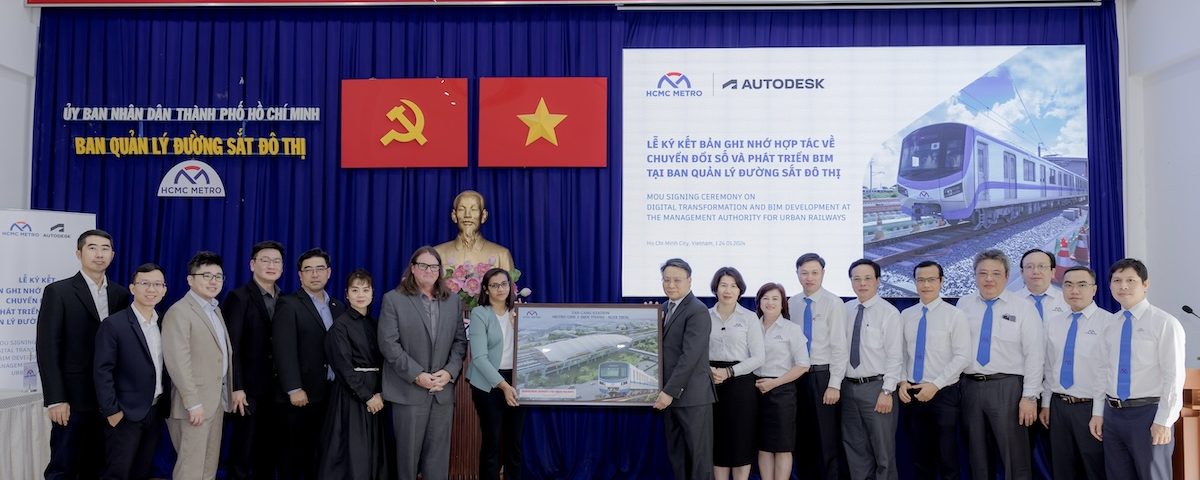
Strengthen Your Security Operations: MITRE ATT&CK Mapping in Cisco XDR
May 20, 2024
Demystifying Multicloud Networking with Cisco Multicloud Defense
May 23, 2024Digital solutions put APAC railway development on the fast track


- The Asia Pacific region is experiencing a surge in rail transportation, with modern challenges being addressed through a shift towards cloud-connected, data-driven approaches like Building Information Modeling (BIM).
- Digital technologies like BIM, are revolutionizing the rail industry by improving data management, collaboration, and decision-making throughout project lifecycles.
- Autodesk is contributing to this digital transformation through a collaboration with Vietnam’s Management Authority for Urban Railways (MAUR), focusing not just on maintenance but also on updating standards to support future socio-economic growth.
The Asia Pacific region is witnessing a significant surge in rail transportation, marked by exciting projects like the Jakarta-Bandung High-Speed Railway and the commencement of construction on Malaysia’s East Coast Rail Link. This growth is driven by the development of high-speed rail networks, offering faster and more efficient connections across vast areas.
Railways have long been a crucial element in the infrastructure development of Asia Pacific, fostering economic growth and linking expansive territories. Today, the region boasts a diverse array of rail projects, from high-speed networks to urban metro systems. These are collectively reshaping transportation for enhanced mobility and reduced congestion, providing sustainable options for millions.
However, modern rail organizations face several challenges: managing costs, a tech talent crunch, meeting more sustainable regulations, and navigating increasingly complex projects with vast amounts of data.
Leveraging digital tools for rail projects
To address these challenges and ensure successful project delivery, the industry is embracing a paradigm shift towards cloud-connected, data-driven approaches. Many experts view digital technologies as the key to maintaining safe and reliable rail infrastructure, even amidst concerns about a skilled talent shortage in the industry.
One technology that could positively disrupt the rail industry is Building Information Modeling (BIM), which is capable of facilitating efficient data management and collaboration to enable more informed decision-making throughout the project lifecycle. A technology-led approach presents a significant advantage for regional railway organizations, allowing them to introduce new efficiencies as projects grow in scale and complexity.
Denmark-based firm Ramboll has used integrated digital technologies, including BIM, to meet the many challenges of urban railroad design. While developing rail projects, such as Norwegian state railway Bane NOR’s Hensetting–Østfoldbanen extension, BIM adoption and use has resulted in fewer errors, more efficient coordination with project teams, and better communication with clients and the community.
Autodesk marked a significant milestone by signing a Memorandum of Understanding (MOU) with Vietnam’s Management Authority for Urban Railways (MAUR) earlier this year. This follows our commitment to supporting BIM application in the Vietnamese transportation infrastructure, as discussed with the Minister of Transport in November 2023. The agreement marks a three-year collaboration where Autodesk will serve as a consultant and supporter for MAUR, promoting successful digital transformation and efficient BIM application in the urban railway sector, with potential for broader impact on the transportation sector as a whole.

Autodesk signed a Memorandum of Understanding (MOU) with Vietnam’s Management Authority for Urban Railways (MAUR) earlier this year.
These efforts are important in the region, considering the pivotal role railways play in Vietnam’s economy, accounting for 30% of the transport sector’s market share as of 2021. As noted by Vietnam’s Vice Premier Tran Hong Ha, railways act as the “veins” linking economic centers to seaports, highlighting their crucial role in strengthening the nation’s economic competitiveness.
The focus on railway infrastructure goes beyond repairs – it extends to meeting updated standards that support future socio-economic growth activities. Plans are currently underway to build a high-speed train network that bridges the economic divide between the northern and southern regions of the country, with the Vietnamese government aiming to commence work on the North-South express rail line in 2030, scheduled to be operational by 2045.
On the right track to railway progress
“Autodesk’s design and make platform will be pivotal in propelling progress within Vietnam and APAC’s urban railway sectors. Embracing advanced technologies like BIM is essential for businesses aiming to expedite their digital transformation journey,” says Haresh Khoobchandani, Autodesk’s Vice President for APAC and Japan. “I am thrilled Autodesk is collaborating with key organizations like MAUR, as it highlights the potential for technology to drive positive transformations in the transportation landscape across the region, ultimately enriching the lives of many.”
As rail projects across Asia Pacific continue to evolve rapidly, the adoption of digital technologies becomes crucial for increasing resilience and overcoming challenges. This is especially pertinent with the growing investments in rail infrastructure around the region, connecting people and places, facilitating trade, and unlocking new opportunities for economic growth. In this context, digital transformation emerges as a key enabler for organizations to maintain, modernize, and sustainably develop rail networks.

